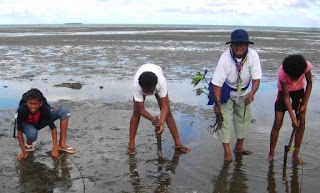Take Action! Long Live the Tangled-root Trees
Now that
significance of the Fijian mangrove forest ecosystem is recognized, the natural
question becomes how do we take action to conserve our tree brothers. The
islands of Fiji demand action by environmentally conscious individuals who have
the power to create legislation and a plan of action to restore and protect the
mangroves.
 The
monitoring and management of mangrove forests requires teams of experts who
must orchestrate cooperation amongst village leaders, and carry out projects on
target sites. In Fiji, all water below the mean high water level belongs to the
British crown although many of the resources within that area are delegated to
the local Fijian people. Before action is taken, all mangrove development decisions
are made by the Lands Department.
The
monitoring and management of mangrove forests requires teams of experts who
must orchestrate cooperation amongst village leaders, and carry out projects on
target sites. In Fiji, all water below the mean high water level belongs to the
British crown although many of the resources within that area are delegated to
the local Fijian people. Before action is taken, all mangrove development decisions
are made by the Lands Department.
The process
of developing a mangrove region for other uses currently entails:
1. A developer submits a proposal to the Lands Department
2. Lands then invites comment from other government
ministries and departments
3. An arbitration process is commenced to assess a
recompense sum for loss of the mangrove and services ("Fiji Starts Environment Project")
4. Public comments are sought
5. A final
determination is made and a foreshore development lease may be granted.
(Agrawala pg. 37)
Within Fiji, I think that one
mechanism for real action also can come through Non- governmental organizations
such as the Organization for Industrial, Spiritual and Cultural Advancement
(OISCA). This group of activists partnered up with groups of local villagers to
create mangrove-replanting projects in areas where forests had been destroyed.
There are many areas of replanting that require expert consultation, so the
University of the Pacific in the capital of Suva should continue to develop its
environmental science programs in order to create professionals within the
Fijian demographic who will be motivated to protect their own local
environment.
I visited the region, called
Sigatoka, where some of these projects are underway and noticed young trees
coming up out of the shallow sandy waterbeds. In Fiji, everything still seems
very third- world, therefore, an environmental protection project must be
managed from an outside source that knows what they are doing. In other words,
operating in Fiji can be a bit more lawless and unregulated than say the United
States. Fiji is an ideal place to educate small local village populations about
the importance of the mangrove forest environment, in order to discourage
further destruction.
______________________________________________________________
Agrawala, Shardul, et al.
"Development and Climate Change in Fiji: Focus on coastal mangroves."
Environment Directorate and Development Cooperation Directorate,
Organisation for Economic Cooperation and Development (OECD), Paris (2003).
"Fiji Starts Environment Project." World Association of Girl Guides and Girl Scouts -. N.p., n.d. Web. 26 Nov. 2012. <http://asia.wagggsworld.org/en/news/20008>.
No comments:
Post a Comment